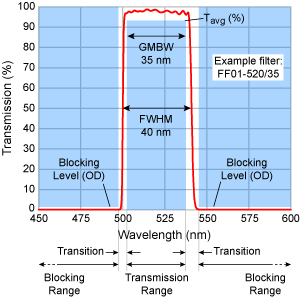

Optical Filters FAQs
Here we have provided comprehensive lists of commonly asked questions regarding our Semrock optical filters and related applications. This information is designed to support your inquiries, but if you don’t find the answers you are looking for we encourage you to contact us for further assistance.
Please use the sort buttons in the left navigation to navigate between questions and answers that are specific to Optical Imaging Systems, Fluidics, Cameras, Microfluidics, our Webstore, and Engineering Partnership.
What is bandwidth?
Semrock uses a “manufacturable specification” approach to define the bandwidth of our BrightLine® bandpass optical filters. We believe this approach more accurately reflects the performance of the filter in an optical system.
As shown in the diagram, the filter spectrum (red line) must lie within the unshaded regions. The average transmission must exceed the specification Tavg (%) in the Transmission Region, which has a certain center wavelength (CWL) and a width called the Guaranteed Minimum Bandwidth (GMBW). The filter part number has the form FF01-{CWL}/{GMBW}.
The transmission must lie below the blocking level specifications (OD) in the Blocking Regions. The precise shape of the spectrum is unspecified in the Transition regions. However, typically the filter passband has a Full Width at Half Maximum (FWHM) that is about 1% of the CWL wider than the GMBW bandwidth,
or

FWHM ≅ GMBW + 0.01 x CWL
So, for the example shown in the diagram, the FF01-520/35 filter has a GMBW of 35 nm and a FWHM of 35 nm + 1% of 520 nm, or 40 nm.
Explore Semrock BrightLine® bandpass optical filters in our webstore.
